
By Marisa Rothstein
Marisa Rothstein, an attorney and certified financial planner, is a Carolina Woman contributing editor.
In the previous edition, Carolina Woman introduced you to our adventurous contributing editor, who's traveling around the world for five months with a toddler in tow. Last month, Marisa trekked through South America with her 19-month-old daughter, Sydney, and her husband, Nolan. Join them now in Australia and Asia.
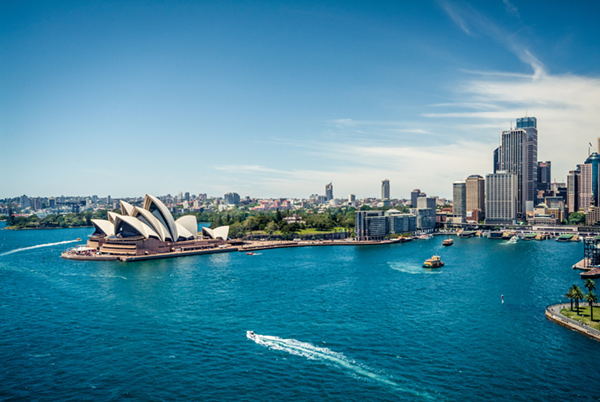 SYDNEY
SYDNEY
A fourteen-hour flight from Chile across the Pacific Ocean landed us in Sydney, Australia's largest city, and my daughter's namesake.
Visiting a place whose name is shared by a family member was at times awkward: passersby thought that we were dissing their city when Sydney misbehaved and that we had an exceptional appreciation for the city when we praised her behavior.
One benefit to visiting a city with a shared family name? Amazing souvenirs. Soon after arrival, we were all sporting "I Heart Sydney" shirts and hats.
And what an arrival! We stood with the rest of the passengers waiting around the baggage carousel. When only a single purple duffle was left circling, we headed to the service counter to learn that our bags had never joined us on our flight to Australia; our packs and travel crib had been mislabeled and sent to Peru.
The airline provided $120 on a prepaid credit card and a "survival bag" consisting of pajamas, toothbrushes and soap to hold us over for the next few days. Conspicuously absent? A travel crib and diapers. That last diaper, already hanging low, would have to last until the pharmacies opened the next morning.
Our first day in Australia was an airline-sponsored shopping expedition. We headed to Paddy's Market in Chinatown, an indoor flea market with hundreds of clothing, souvenir and jewelry stalls. Dressed in new duds, we ended the day with dim sum in one of Australia's authentic Asian restaurants.
The next day, we explored Sydney. At Bondi Beach, swam with the buff surfers; at Sydney Harbor, strolled with the locals; and at the nature reserve, fed kangaroos and wallabies.
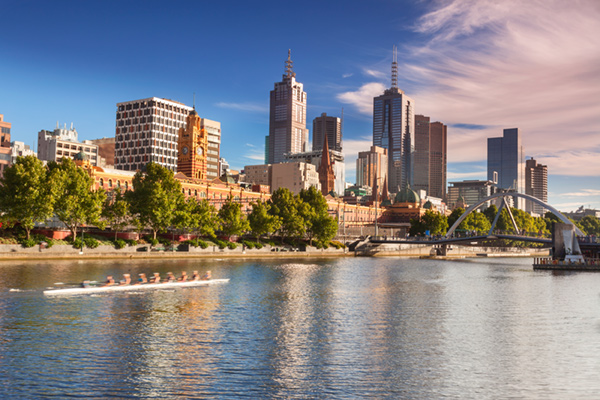 MELBOURNE
MELBOURNE
After a week, we flew two hours south to Australia's second largest city. Melbourne, consistently ranked the best place to live in the world by The Economist, has an abundance of centers for art, culture and science as well as great ethnic and culinary diversity. With prices significantly lower than in Sydney, it was much easier to enjoy all that Melbourne had to offer.
On our first day, we strolled through the Queen Victoria Market where we played music on a public piano and picked up reading material at a free book exchange. Then we wandered through the Melbourne Museum, where we inspected dinosaur fossils up close.
Another day, we visited the city's ancient jails. Australia was founded as a British penal colony in 1788 and served as such for over a century, so the country's oldest sites are prison-related.
At the Old Melbourne Gaol, for instance, we learned about the legendary bank robber Ned Kelly. After decades of violent police confrontations and evasions, Kelly was ultimately imprisoned and hanged in the jail square.
My favorite attraction was the nightly Fairy Penguin Parade. To get there, we hopped on a Go West tour van. When it arrived, we were welcomed by a merry group of three Carolina women. Coleman, who had just graduated from high school and spent a year living and working in Sydney, was exploring the country with her Aunt Debbie and her mom, Cindy.
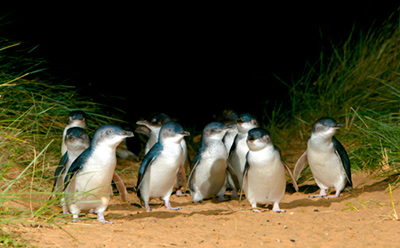 My new friends and I spent the day sharing Triangle restaurant recommendations and trading hard-learned travel tips. Here, at the very southern tip of Australia, I felt right at home.
My new friends and I spent the day sharing Triangle restaurant recommendations and trading hard-learned travel tips. Here, at the very southern tip of Australia, I felt right at home.
The Fairy Penguin Parade was remarkable. Thousands of foot-tall penguins waddled up from the ocean, scurried along the shore, and burrowed into their respective homes, little holes scattered around the coastline.
As the sun set, a couple of little penguins waddled past us. And then a few more. The darker it got, the more penguins came. Hundreds were soon crossing over the beach. They squawked to one another, like old friends gossiping. When one fell over his stubby feet, his neighbor waited for him to get up before moving on.
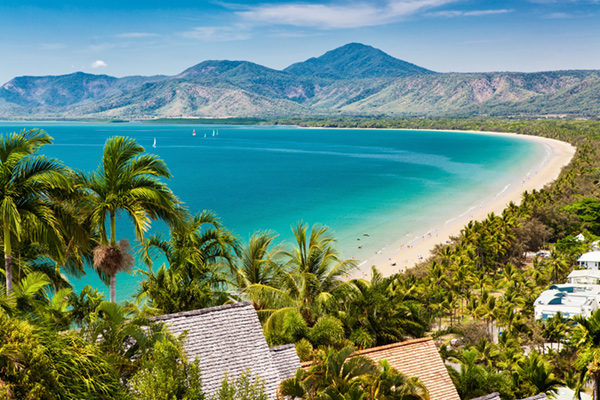 PORT DOUGLAS
PORT DOUGLAS
From Melbourne, we traveled north to Port Douglas, home to both the world's oldest rainforest and the Great Barrier Reef, so enormous that it can be seen from outer space.
We checked into one of the first hotels of our trip: Thala Beach Nature Reserve. Having spent more than a month moving from one Airbnb lodging to another, we were elated to sip fruity welcome drinks at the check-in desk.
At Thala, we had access to miles of private, white sand beaches and trails through the rainforest. As Nolan jogged down the pristine coastline, Sydney and I napped in hammocks hanging between coconut trees.
On a day trip from Thala, we boarded a Quicksilver Tours boat to explore the Great Barier Reef, one of the seven wonders of the natural world. Divers and snorkelers come from around the world to swim with more than 1,500 different types of fish, 134 species of sharks and rays, and 30 kinds of marine mammals.
At a floating platform two hours out from the coast, we wiggled into wetsuits and jumped into the delightfully warm water. Nolan and I took turns holding our daughter, who floated along in her life jacket while peeking into the sea.
Bright, colorful coral decorated the ocean below us. Schools of small fish swam directly in front of us, close enough to touch. Larger neighbors sent smaller ones scattering. I heard the crunch of tiny fish munching on coral.
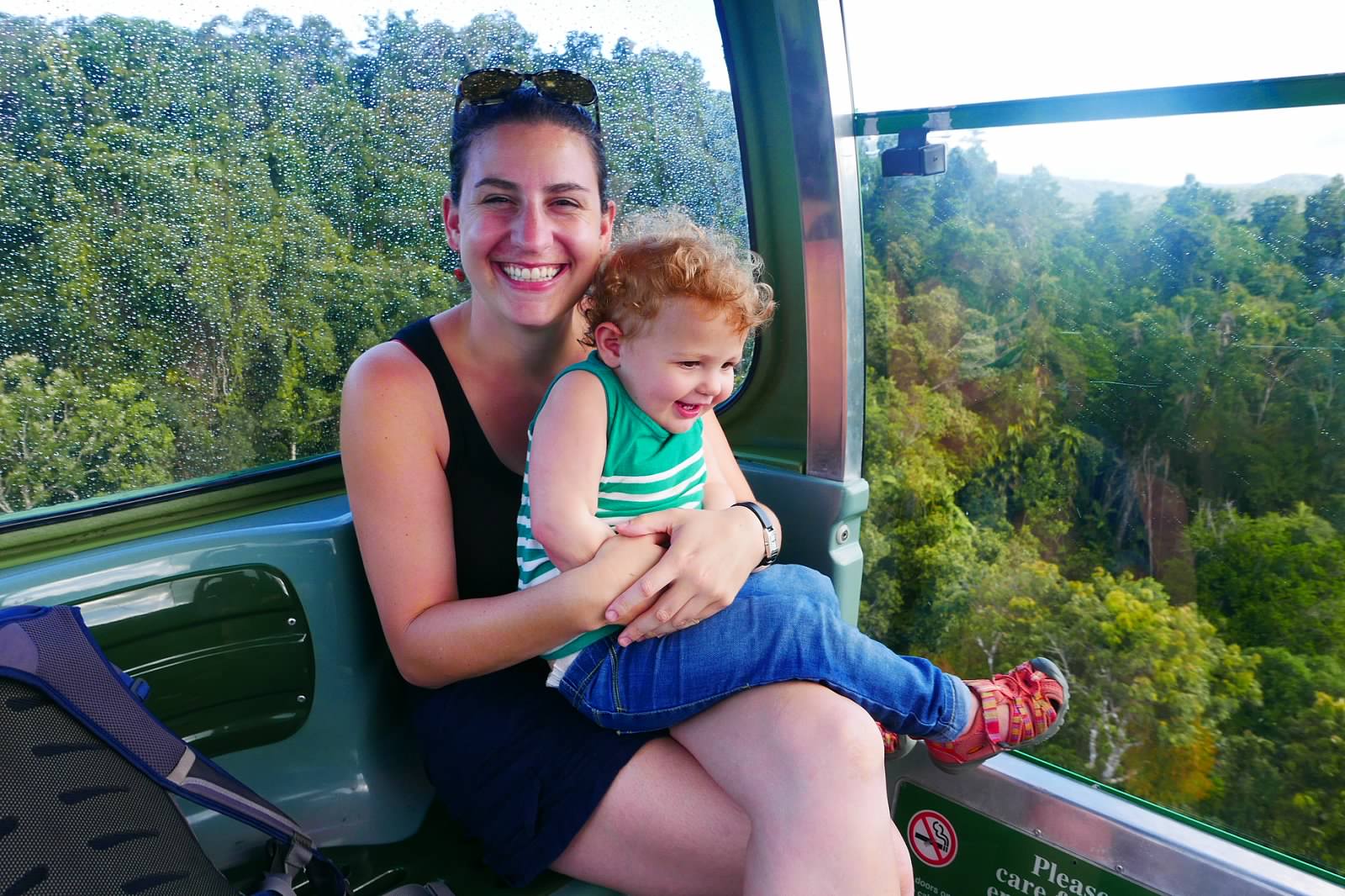 On our last day in Australia, we gawked from an enclosed cabin as the Skyrail lifted us above the rainforest. Once deep within, the car descended below the tree line, stopping for us to get off and stride along a wooden promenade through the ancient landscape.
On our last day in Australia, we gawked from an enclosed cabin as the Skyrail lifted us above the rainforest. Once deep within, the car descended below the tree line, stopping for us to get off and stride along a wooden promenade through the ancient landscape.
As we walked, I felt a tug on my shirt. I looked behind me. Nothing there. Again, a tug on my shirt. Now I investigated more closely. Latched onto the shoulder of my shirt was a thin, green branch. I struggled to detangle myself.
A nearby tour guide shouted to stop. He then introduced us to these spiky vines - called "wait-a-whiles" because once they grab onto your clothes, the best course of action is to stop moving and slowly detach yourself.
Extremely common in the North Queensland rainforest, these vines have sharp spikes which enable them to climb up larger trees to reach the sunlight.
Having had a first hand experience with the inhospitality of the Australian rainforest, we marveled at how Aboriginal people had survived here for more than 40,000 years. Aborigines cut paths, built small clearings, and constantly moved between areas depending on the weather and rainfall.
From the Skyrail, we headed to the international airport for a late-night flight to a new continent: Asia.
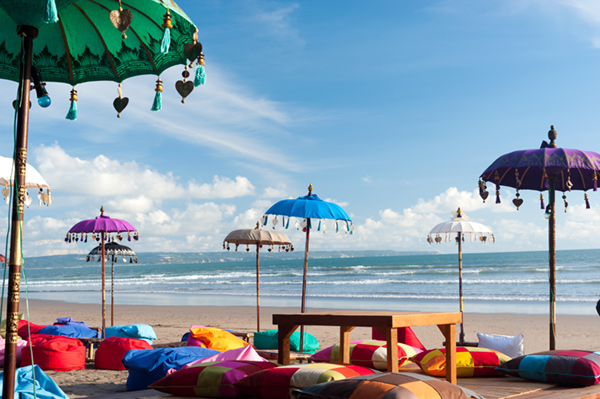 BALI
BALI
Our Asian exploits began in Indonesia, the world's fourth most populous country, comprised of a chain of thousands of islands spread across the South Pacific. Bali, the most popular tourist destination of the archipelago, is called the "Land of 1,000 Temples" because of its numerous Hindu temples and shrines.
Arriving in Bali at three in the morning, we were greeted by heavy, humid air. I started sweating before we exited the airplane and continued until we arrived in Japan two weeks later.
We collected our bags and headed to the exit. As we stepped outside, we experienced our first sting of real Balinese heat. That's when we realized that the airport had been air conditioned! Melting under 30-pound backpacks, Nolan and I waved down a taxi to take us to the hotel.
Barely three minutes later, we stepped out at the hotel, and balked when the driver demanded $25 for the ride. The hotel was only $20 a night! But with our belongings held hostage in the trunk, we had no choice but to hand over the cash.
In the morning, we asked the hotel clerk to call a reliable cab service for us. We were driven 30 minutes south to Jimbaran, a traditional fishing village. The cost: $4.
Our next stay was at The Open House, an intimate boutique hotel nestled between traditional temples and houses in Jimbaran. We jumped into our bathing suits and sprinted the two blocks to the beach, hoping for a reprieve from the suffocating heat. At the shore, we threw our sandals aside and hopped into the refreshing surf.
Once floating in the calm ocean, we were finally able to breathe deeply. To the right, some restaurants and lounge chairs dotted the beach. To the left, fishermen cleaned and repaired colorful wooden boats. Waves lapped over white sand for miles and miles in either direction.
Still floating, we decided to eat lunch at one of the beachside fish restaurants. In the time we had been in the ocean, the tide had gone out and the sun had risen higher, baking the sand to scorching. Carrying Sydney, we ran, yelping as the hot sand scalded our toes. Quickly forgetting the pain, we selected just-caught fish to be filleted, grilled and sprinkled with just enough lemon juice and pepper.
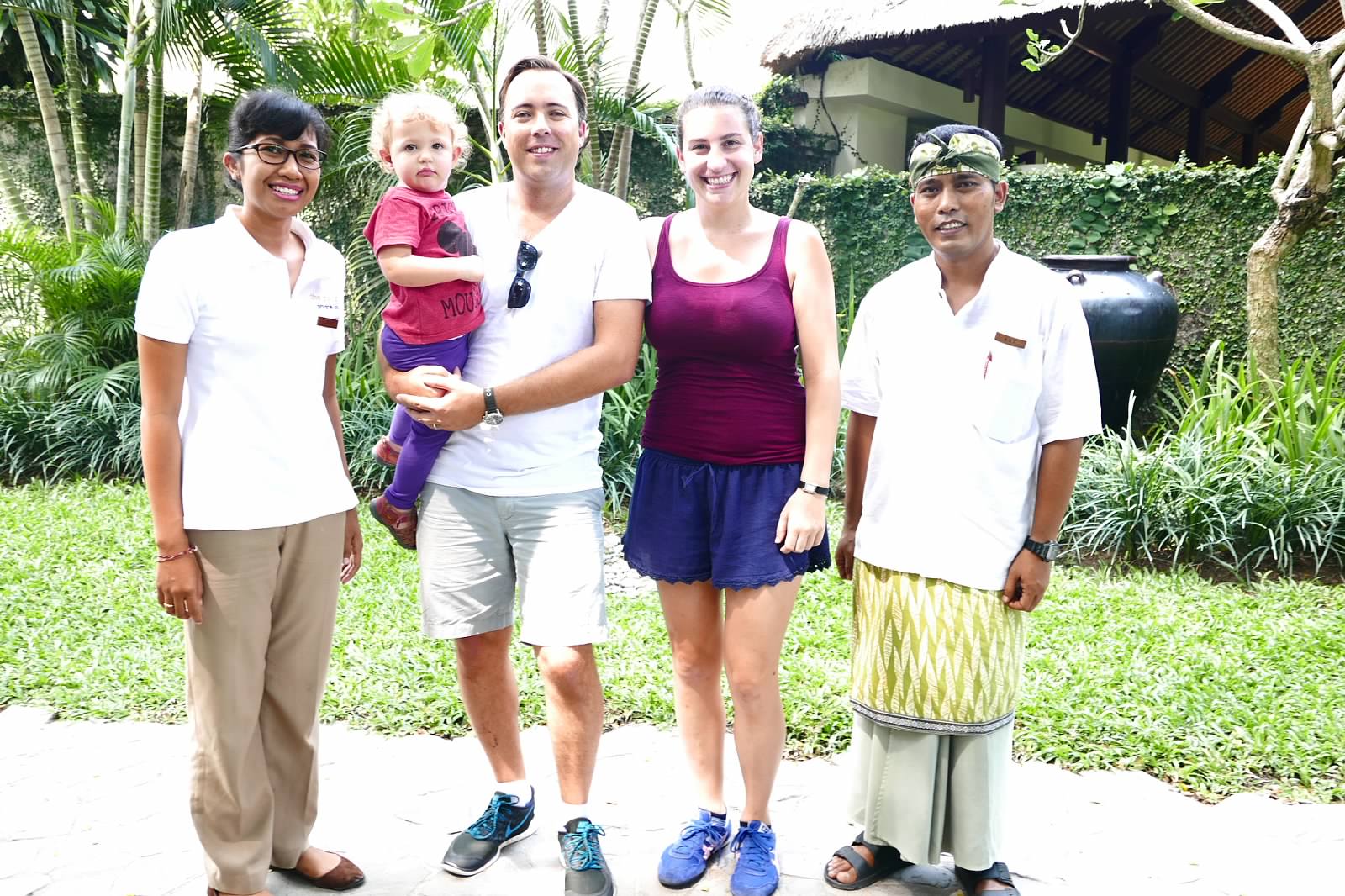 The next morning, Wayan, whose family runs an island tour company, arrived to show us the major sites of Bali from a delightfully air conditioned van. Over the course of the day, we waved hello to farmers tending rice in the paddies; danced under a cool waterfall; and meditated at serene temples.
The next morning, Wayan, whose family runs an island tour company, arrived to show us the major sites of Bali from a delightfully air conditioned van. Over the course of the day, we waved hello to farmers tending rice in the paddies; danced under a cool waterfall; and meditated at serene temples.
Wayan escorted us around the island for the next five days. He wanted to be sure we fully appreciated Balinese culture and tradition. One day, we visited the Ubud Monkey Forest, where cheeky rascals nibbled bananas out of our hands.
Another afternoon, Wayan invited us to his house for lunch with his family. Although of only modest means, his mother put out an amazing spread of classic Balinese dishes.
As 10 chickens clucked around us, we sat at an outside table. After lunch, Wayan's wife took us on a tour of their home, a compound housing three generations of extended family. In the front was a small temple where a rooster pecked at the daily offering. A mama hen and her four-day old chicks waddled on the dirt ground under the sink in the kitchen.
Before leaving, we gathered for a picture and promised to host Wayan and his family just as generously should their dream of seeing America come true.
For our last few Balinese nights, we checked into The Gangsa Private Villas on the southeast coast of the island. The Gangsa was wonderful because it felt like home.
The lodging provided many familiar comforts that we hadn't enjoyed in months. The staff treated us more like family than customers, showing us through the lush, flower-filled garden and teaching us to strike the hotel gong.
One our last day in Bali, The Gangsa's chef took me on a private tour of the local fish market. Barefoot men carried enormous specimens from the sea to a scale monitored by weathered women who, in turn, auctioned off the fish.
The winners returned to their market stalls with their bounty and displayed it to the chef and other buyers. Back at the hotel, he turned our catch into a spicy delight. It was a wonderful, exotic last taste of Bali.
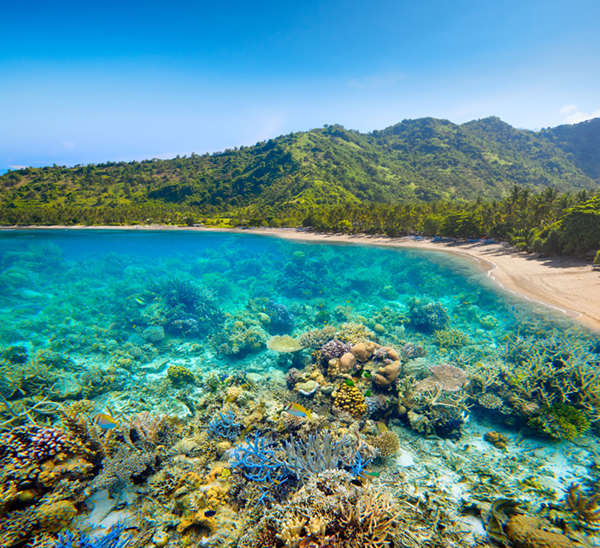 LOMBOK
LOMBOK
From Bali, we flew 45 minutes east to the neighboring Indonesian island of Lombok, which is overwhelmingly Muslim, agrarian and untouristed.
On the two-hour ride from the airport to our lodging, boys on mopeds swerved around us on their way to school while women, some wearing hijabs, carried baskets of fruit and vegetables.
Our driver pulled off in the middle of a steep climb through the rainforest to point out wild monkeys lounging along the roadside. On the other side of the mountain, we continued through a town of corrugated steel houses, where bare-bottomed little boys played beside their family's livestock.
Finally, we arrived at our destination: Hotel Tugu Lombok. Tugu, designed and decorated by the biggest collector of Indonesian antiques, was like a museum.
Its location was equally magnificent. We kayaked and snorkeled among orange, purple and yellow coral. On our last morning in Lombok, Sydney and I hurried out early to catch the sunrise and then combed the beach for shells to bring home as souvenirs.
Sad to leave, we packed our belongings and headed to the airport for a flight to Japan.
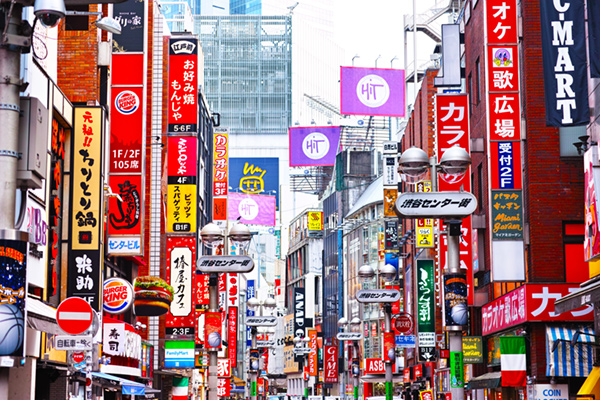 TOKYO
TOKYO
In Japan's capital city, we learned that seashells weren't our only souvenir of Lombok: We had also brought along sea lice. A macrobiotic parasite that sneaks into bathing suits and bites the skin, it causes bumps that look like acne but feel like chicken pox and can take up to four months to disappear.
With good fortune and strong anti-itch cream, our bumps stopped itching within a couple of days. Quickly, we delved into Tokyo's incredible cuisine, the highlight of our stay in Japan. By the time I slurped down my second bowl of ramen soup, I had nearly forgotten about my Indonesian memento...despite the trail of red marks across my belly, which would disappear only a full month later.
Six of our seven days in the city were spent at a modest Airbnb apartment in which Sydney, Nolan and I snuggled up to sleep on the same futon where we ate our meals.
But to celebrate our fourth wedding anniversary, Nolan and I super-splurged, checking into the Ritz-Carlton for one night.
Sydney bounced ecstatically on her own plump, cushiony queen bed, and I soaked for two hours in the enormous bathtub. Even here, food was the star. At high tea, we were served three tiers of delectable hors d'oeuvres, including salmon sashimi, smoked trout canapés and chocolate mousse.
I was in a state of bliss. Filling up on exquisite bites, being pampered by the staff, basking in the elegant setting. Drink it all in, I thought, because this is once in a lifetime.
Coming next month to carolinawoman.com:
The trip continues in Europe.